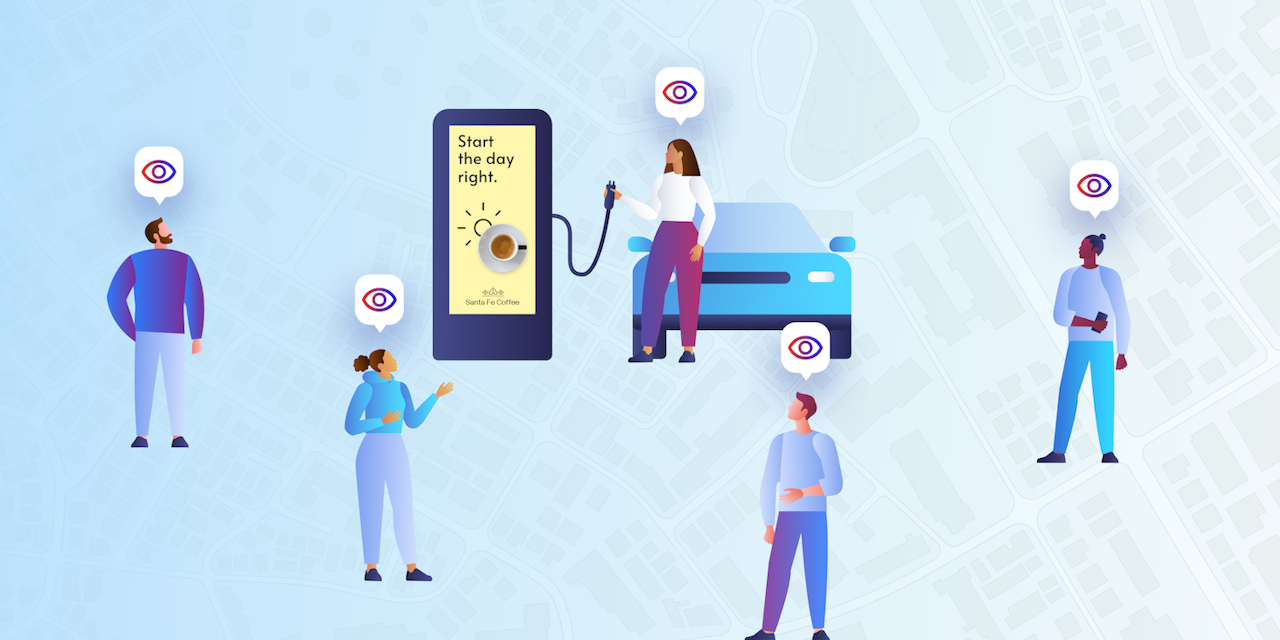Broadsign
We’re making it easier than ever for agencies and marketers to harness the power of digital out-of-home by making screens in airports, shopping malls, transit systems and more, in the heart of the world's busiest cities, available programmatically.
This promoted content is produced by a publishing partner of Open Mic. A paid-for membership product for partners of The Drum to self-publish their news, opinions and insights on thedrum.com - Find out more
Unpacking opportunities in EV charger advertising
October 19, 2023

By Catherine Lee (Broadsign product marketing specialist)
Demand for electric vehicle (EV) charging stations has grown exponentially throughout 2023 as EV adoption has soared; more than a million new plug-in electric cars were registered globally in May 2023 alone.
The trend is fueled by the evolution of micromobility and new electric vehicle launches as governments regulate gas-powered vehicle sales worldwide. To this end, the EV charger footprint is rapidly expanding, especially in large city shopping areas. Innovative players like ChargeEuropa, Numbat, Revolt, and Swiftmile are building out networks to help EV owners and Light Electric Vehicle (LEV) users power up cars, scooters, bikes, and more in public spaces, and brands are taking note of the chargers’ premium LED screens, which can play dynamic ads.
Advertisement
Picking up steam
Increasingly popular for their ability to reach consumers during their daily routines with high-quality, eye-level screens, ad display-equipped EV and LEV chargers are transforming digital-out-of-home (DOOH) advertising. They provide a way to target a captive audience – whether the EV operator or passersby – on the path to and near the point of purchase. This is an especially appealing proposition for digital advertisers amidst the death of the cookie. With more ad display-equipped EV chargers surfacing globally, the industry is moving deeper into this uncharted ad channel, which introduces new opportunities.
Commenting on the trend, Walter Smet, marketing lead at Revolt, notes, “It’s an exciting time, especially as the number of EV users on the road multiplies. The opportunity for advertisers is targeted visibility on car parks at new locations outside the home, like hotels, football clubs, or big corporate offices, where fewer advertisers are usually present. These locations where specific audiences gather, coupled with the ability to advertise with animated content , are becoming more important as we move into a cookieless era. This emerging channel is capturing the attention of marketers seeking both high relevance and scale.”
Numbat head of marketing, Uli Benker, shares the unique value proposition of EV charger advertising in connecting with increasingly carbon-conscious audiences. He says, “Implementing more sustainable advertising practices is increasingly important to brands and media agencies, and, in most cases, EV charger networks are designed with sustainability in mind. At Numbat, for instance, we can use solar PV (photovoltaic) to power our chargers for 100 percent green electricity.”
Joel Martin, swiftmile advisor (also chief media officer at chargeFuze), adds, “Whether or not media buyers or audiences recognize it, advertising on these sustainable kiosks can make a difference, especially in comparison to other ad formats, and it’s something consumers who are looking to interact with brands focused on sustainability will notice.”
ChargeEuropa also sees the value of EV charging networks as a potential lead-gen source for marketers. One of its car manufacturing clients launched an interactive ad that allowed viewers to input their contact info, and they were invited to test drive the vehicle nearby. Reflecting on the campaign’s success, ChargeEuropa CEO Matt Tymowski said, “We got solid client feedback that the campaign generated high-quality leads, and many of our other clients have also expressed positive feedback. It’s become clear that brands want to be front and center on a valuable piece of infrastructure.”
An advertising format where anything goes
EV charger displays present premium ad real estate that can help brands of all kinds, including local businesses, and media planners maximize ad exposure to audiences at times when they’re more inclined to make a purchase. Some screens even feature touch-screen capabilities, data-driven personalization, and contextual messaging based on driving and charging patterns. Location-based media placement on these displays, especially close to the point of sale, is one of the many benefits the medium offers.
As for who presently uses the medium, Benker has seen regional and local brands leverage Numbat’s screens across Germany to promote offerings and even job postings. He says, “We’ve seen it all, from big brands (i.e., RedBull and Paramount +) to small brands. Some run standalone content, while others run spots as part of a larger omnichannel campaign. Naturally, we also see many EV brands advertise on our screens. It’s a mixed bag that will only grow more diverse with time.”
Adding to the conversation, Smet notes that ads from automotive, mobility, and energy companies make up the bulk of media buys on its network but that it varies broadly. What most ads on the network share in common, however, is that they tend to use ten seconds of animated content as part of larger awareness campaigns. That said, he recently saw an ad run on the network that showed the latest news reports dynamically. “The medium just provides so much flexibility and control,” he explains.
Ads that run on ChargeEuropa’s network of screens are often part of an omnichannel campaign, but Tymowski says he’s also seen standalone ads that use an omnichannel template with the copy altered for EV charging context. “This keeps production costs low while adding a punch to the EV charger ad, which is smart,” he says. “The great thing about this market is it's young, so there’s a lot of room for experimentation."
CPG brands like Pepsi and Liquid IV represent just a few of many brands that have advertised on the Swiftmile network with great success, but Martin urges more advertisers to dive in and start experimenting now to better understand the space. He says, “EV charger advertising isn’t going away, and there will be different types – from EV, bus, and bike chargers to outdoor phone chargers. Now is the time for brands to learn about the space, and how it can augment their messaging.”
Navigating roadblocks
While EV advertising poses many advantages, hurdles remain, primarily tied to infrastructure considerations, costs, and local government buy-in. With the industry still emerging, however, there’s still a lot of room for problem-solving. Martin explains that many cities impose digital signage restrictions, but both EV charger developers and advertisers can work together to convince city leaders of the value that EV charger advertising networks can bring to the community and their audiences. Without them, he says, “Finding the budget to support the scooters and bikes that people depend on for transit, just won’t be as easy. There are also misconceptions that these networks are costly to get up and running, and maintain, which is another obstacle, but most don’t realize that a large portion of those costs can be offset by ad revenue.”
Reinforcing Martin’s point, Smet explains, “One of the big challenges to developing EV charging infrastructure is the high investment cost. In the Netherlands, we need hundreds of thousands of additional chargers to be installed in the coming years, yet most car park owners don't have the budget to pay for these chargers. We’re trying to remove this barrier by taking part of the advertising income to fund charger installation, and in most locations, we can even provide chargers for free.”
Still, Benker notes further bottlenecks must be addressed, from streamlining permit processes to planning for environmental conditions where chargers are located. Also reinforcing the importance of location, Tymowski believes there is more work to be done by EV charger CPOs in positioning station chargers in parking lots in such a way that optimizes EV driver access and maximizes visibility for advertisers. He explains, “We have yet to see this done scalably and cost-efficiently, but believe a modular approach to hardware design is the solution.”
Tymowski is also working to bridge the knowledge gap between two previously disparate industries. He explains, “Most financiers in the energy space don’t understand advertising, and the same goes for advertising financiers with the energy space. Internally, we’re trying to bring ex-energy and ex-advertising people together with financiers from both sides to grow the business successfully. Once more major financiers from both fields are active and experienced, you’ll see a meta-trend happening in this space.”
From Smet’s perspective, the industry is still very nascent, which means there is still room for growth. He says, “The biggest challenge for the medium is how new it is. Revolt was the first in the Netherlands to introduce chargers with advertising screens, not more than two years ago. In many cases, when we speak to advertisers or media agencies, we are still introducing the medium. Imagine what will be possible when everyone is familiar with the medium.”
As the industry charges ahead, a big challenge will be keeping pace with the hundreds of thousands of additional chargers that need to be installed to keep up with demand. As many car park owners don't have the budget to pay for these chargers, advertising screens will become imperative to accelerate the transition to cleaner mobility. With the continued evolution of EV charger advertising in the next decade, the ad industry is in for an exciting ride, but now is the time to get on board, or run the risk of missing out.


